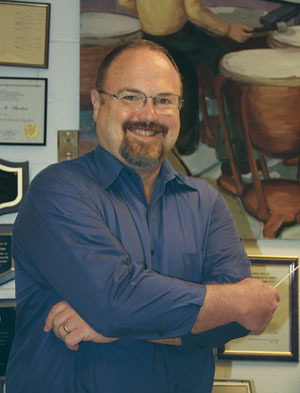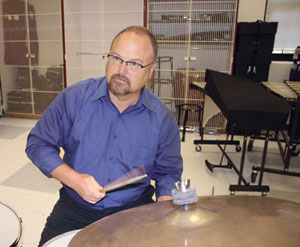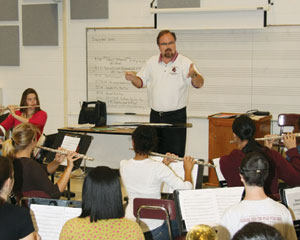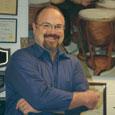The path to success for Steven Barton started in Iroquois, South Dakota in 1976. Barton had graduated from Indiana University of Pennsylvania and an ongoing recession and limited jobs led Barton to take a job in a rural district with just 500 students. “I spent many Saturdays watching the instrument repairman, trying to learn how to make my own repairs so it didn’t take two weeks to get an instrument back.” Barton has subsequently taught at several schools including 15 years at Manchester High School in Virginia and now in his current position at Thomas Dale High School in Chesterfield County, Virginia. Despite all of his success, including the publication of several works for band, “on some days, I still miss Iroquois.”
 How has your work as a composer and percussionist changed your teaching?
How has your work as a composer and percussionist changed your teaching?
I think composing has made me a better teacher and conductor because I have an improved understanding of the music and what the composer intended. Last year we performed Howard Hanson’s Chorale and Alleluia, his first piece for band. As I was studying the score I could see elements of his orchestral background in the scoring. There were certain parts where the scoring didn’t really work with a modern concert band. There was one countermelody that just didn’t come through with a 75-piece concert band instead of the smaller Eastman Wind Ensemble, so I rewrote a couple of measures to make that line stand out to the audience and judges. I do not think of that type of change as cheating but rather as an effort to be faithful to what Hanson originally wanted.
I haven’t composed as much as some but my early efforts date back to my first job in Iroquois, South Dakota, where I started with 28 students in grades 7 through 12. The small instrumentation made many pieces impossible to play. I would rearrange some works just so we had music to play. I had never trained as a composer and never thought of myself as one. I imagined that composers sat around thinking esoteric musical thoughts all day.
In my job at Manchester High School in Virginia, I had a student who wanted to write a piece for jazz band to earn additional academic credit. As I helped him I started to wonder why I had never written an original note in my life. I decided to write a basic ABA overture. I sent it to composer Jack Stamp, a good friend of mine for his opinion. I knew he wouldn’t sugarcoat his response and fully expected him to say “build a fire and don’t try composing again.” Instead, he asked if there were written parts for the piece.
This was in the time before music notation software became popular so I spent the better part of the summer writing out individual parts by hand. I sent off the parts in the fall and a couple of months later, Jack asked if he could program the piece with an honors band at Indiana University of Pennsylvania. He has been so supportive of my composing and took me through that first composition to show what worked and what didn’t. Now when I am writing I always think “would Jack approve?” He has a quiet way of encouraging people and will play pieces that people have written just to give them a good reading and offer suggestions. Jack Stamp probably has more responsibility for my composing than anyone else.
How has composing original works affected your interpretations of pieces by other composers?
Some conductors want to put a distinctive interpretive stamp on a piece, which is a valid approach, but I try to match the composer’s intent as closely as possible. I have discovered than in older literature there was much more editing by the publishers, adjusting such elements as metronome markings and changing the key of a piece so that it sells better. I remember Jack telling me to give specific instructions in my work to avoid having an editor substitute his judgment. I try to give tempo markings in words but also slip in an occasional metronome marking somewhere.
I have noticed with my work that composers are sometimes the worst interpreters of their music, so I try to be specific with my markings. This spring our high school celebrated its 100th commencement and I wrote a piece for the occasion. I decided to write a musical production including the band, orchestra, and chorus. This was the first time I had written for an ensemble of that size, and I collaborated with the orchestra director to make sure that the string parts actually worked. I discovered that string articulation is nothing at all like writing for winds. The orchestra director helped me write string parts that didn’t sound as if they were written by a band guy.
During rehearsals I discovered that my marked tempos were way too fast and frantic. I learned that the proper tempo was considerably slower than I had in mind originally. Tempos are one area where a conductor can show some flexibility in interpreting the composer’s intent. Most pieces have a groove, and locating that is part of the trick of conducting. The correct tempo may be different than what is marked on the page.
 When rehearsing with your three concert bands, do the percussionists have a separate class?
When rehearsing with your three concert bands, do the percussionists have a separate class?
We have had percussion class in the past but scheduling problems made this difficult to continue. Because my co-director, Dave Holley, and I are percussionists, we know that if a student does not know what the rest of the band is playing, a cymbal crash is just a cymbal crash. Percussionists need to know how their parts fit with the rest of the band and this only happens through a full rehearsal. Any percussion ensemble work happens after school for those who want to participate.
Playing crash cymbals is much more difficult than people think, and there are many different types of sounds, including such a thing as a legato crash. My college band director once asked me if there was any way to get a cymbal crash to crescendo. I looked him as though he was nuts but then got an idea. I squatted down next to the floor, and when the time came I hit the crash and then let the cymbals ring while I stood up. This was exactly what the director wanted. The fun part of being a percussionist is the
opportunity to be creative.
How popular is the AP music theory class you teach?
There is a limitation on how many electives students can take, but each year about 25 students take the class. Students generally are unprepared for music theory. We spend so much time working on performances and preparing for the next concert that we do not have the time to work on understanding chord progressions and scales. In some ways it is difficult to make theory exciting; a major scale doesn’t become interesting until you understand what you can do with it. I have to encourage students to bear with me during the early part of the class.
Eventually we start projects where students do their own writing, which some of them initially think is beyond their abilities. It’s really fun to hear students who were initially reluctant write something that really sounds cool to them. I set tight parameters for composing projects. I might assign a 32-bar song with an AABA form, but have noticed that form is often the first thing that gets forgotten in student compositions. Students can write all of the notes and chords but do not know how to hang these on the skeleton of the form
Teaching students to compose using the assigned form is particularly difficult. I remind them that in speech, a sentence will have a subject, predicate, and verb, not just a jumble of words. The same is true in music. Many students have a light bulb moment during the year when they discover the importance of form.
One reason that students may not know as much theory as they should is that so many pieces are written in the big three keys: B flat, E flat, and F. I have heard directors blame the publishers and there is some responsibility there, but publishers are in the business of making money and will print what we buy. My favorite key is D flat because it is a nice warm-sounding key that allows everybody to play in a middle range.
I wrote a lullaby called Cradlesong in D flat major and really liked the mellow sound. Directors have come up to me and asked why I used that key. My only response is that it sounded good to me and that students can learn any key with practice. The composer Timothy Mahr once commented that if he had written his Fantasia in G for the key of F it would have sold twice as much because people are scared to death of G. Certainly there are some keys that are worse for bands, but generally speaking, keys are keys.
Wind instruments tend to have a harder time playing keys like E and B in tune. It takes a bit more work and practice. One year we were playing the Calliet transcription of Elsa’s Procession that starts in E flat, goes up a half step to E major in the middle, and then returns to E flat. The students were having the worst time with the E major section. I wrote out the chord progression in whole notes as a warm up and then had each section play its part in the piece up against the whole note warm-up. Suddenly students saw how notes they were playing in the music fit the chords.
We tried a similar approach with Holst’s Marching Song a couple of years ago. Students had trouble because the piece is modal. The chords did not go where they expected. We simply wrote out the chords in basic half note and whole note chords until they could hear the progression. Once students could hear the harmony without all of the motion going on in the music, they were able to play the piece very well.
What is your approach to improving an ensemble’s sound?
To begin students have to have a good understanding of how to create a characteristic sound. If they don’t understand what a clarinet or trumpet should sound like, the music will sound bad. An audience can forgive a wrong note but poor tone leads to bad intonation and makes the entire performance suffer. Coming from a drummer’s perspective, I learned about good posture and use of air on the job.
Good warm-ups were not part of my experience in high school and college, and when I started teaching I did not see the point of spending considerable time on these. Eventually I had an epiphany after listening to outstanding groups and asking directors how they reached that level of excellence.
Often I use chromatic exercises where we start on a concert F, go down a half step, return to F, go down a whole step, and so on. We will mix the exercise up by having the woodwinds playing normally and the brass just on mouthpieces. It was also a revelation to me that brass players have to buzz the exact pitch on their mouthpieces. I thought the buzz changed depending on the range, but I didn’t know that it was essential to play the exact pitch. When the brass put their mouthpieces back into the horns, the sound is considerably improved.
 What methods have you used to combine warm-ups with instruction on new skills?
What methods have you used to combine warm-ups with instruction on new skills?
This year I tried some different warm-ups and exercises to help students understand progressions and intervals. During one rehearsal I asked, “Who has the third?” and received only blank stares in return. They had no idea, and there was no reason for me to expect otherwise. I devised some basic warm-ups with students playing in octaves on a whole note and then half of the band playing the fifth on a second whole note. The fifths were labeled on the exercise so students could know how a fifth sounded. We tried different variations of going up and down in parallel fifths. When the same intervals came up in music they recognized them and knew what was necessary to play them in tune. I tried the same exercises – adding thirds to open fifths and sevenths to major and minor triads – and it was amazing to see students discover how these intervals fit into the music. It blew their minds to hear that an E in F major sounds different than an E in C major.
I have really worked to develop my own warm-ups in the last couple of years. Most of the published books are really good and deal with many of the same techniques. We all grew up with the Treasury of Scales and some of the exercises are magnificent but others work less well. I think anyone who has ever worked with that book goes back to a few favorites. Other books may use chorales to focus on tuning or some technique. Most of the books tend to stick to the same basic concepts.
There were some important ideas that I’d never seen in a book before, and I started to think about what I would put in a supplement. We frequently discuss that moving parts are usually more important than sustained notes. If a section has eighth notes in a chorale, it is probably the most important. I wrote a chorale that gives everybody motion at different spots, just to show how there are times to step into the spotlight and other times to step back.
I have also seen brass double-tonguing exercises that leave the woodwinds staring off into space. I wrote a difficult double-tonguing exercise that gave the upper woodwinds a chromatic run in sixteenths that gave them work on fingering. It doesn’t take 32 bars to work on these ideas. Even brief lines of four bars each can help teach certain concepts. Notation software programs make it much faster to write original warm-ups for students. Teachers can get into a rut by following a book line by line or always worrying about the number of rehearsals until the next concert. It is easy to fall into the trap of coaching instead of teaching.
Part of my growth as a teacher is to think of new and better ways to teach certain ideas. It can be so mind-numbing to play the same exercises and pieces day after day. I have always learned a great deal from watching the rehearsals of other successful directors.
 What are the most prevalent weakness that you see in your students who have not played much jazz before high school?
What are the most prevalent weakness that you see in your students who have not played much jazz before high school?
Style is by far the greatest weakness. Some students will come up from middle school with a sense of the swing style and everyone is familiar with rock. Latin music might as well be classical to them. Students are also intimidated by improvisation. Many of us tend to approach teaching improvisation from a classical approach and encourage students to play particular notes at a precise time. In many playing situations the right note on the wrong beat is a wrong note. In soloing students have to understand that there are fewer wrong notes. You tell them which 6 notes work best in a 12-bar blues, and this takes away the worry about hitting a wrong note.
I always joke with students, “if you hit a wrong note, we may laugh a bit but it is okay. Nobody gets out of here without making a mistake.” The key is to learn from the mistake so that next time you do not play a B during a Bb blues scale. In the same vein we tried a scat singing exercise. On the first chorus the student scatted without an instrument and on the second time students played the music they heard in their head rather than focusing on pushing buttons. The results were amazing. Sometimes a student will finish the instrumental chorus and wonder where the notes came from. Within their own technical skills, everybody can play a solo.
There are still many aspects of jazz that I am learning about, so I steal unashamedly from clinicians and teachers who have good ideas. In classical music the low note received the emphasis; we always drive to that lowest pitch. In swing charts the high note gets the emphasis. That simple change in emphasis affects how you approach a swing line.
Sometimes I will see drum set players pounding the bass drum on all four quarter notes like a rock band. You have to explain to them that the bass drum, even though it is not in pitch, is in the same frequency range as the upright bass. Every time he pounds the bass drum, he’s simply adding musical mud and masking the frequency of the bass. Swing drumming is all about the ride cymbal and the hi-hat. The snare, tom-toms, and bass drum are used more for accenting certain notes than driving the beat. There have been times when I have taken the bass drum pedal and snare drum away from the drummer to spur more creative playing.
The greatest drum solo I ever saw was years ago by the legendary Max Roach. He came out on stage for a clinic with just a hi-hat and showed more creativity than most players can with a huge drum set. He said at the time that if you cannot play creatively with a ride, a crash, a hi-hat, snare drum, two toms, and a bass drum, then adding more toms and cymbals will not help. It is difficult to convey a sense of swing and how to kick the band in because most students do not listen to Sinatra or Basie records unless we play them in class, and the written rhythm parts are often not very helpful for young players trying to understand how they function.
What advice would you offer to young directors?
Many young directors make the mistake of trying to get into a large, high-powered program from the start, where beginner mistakes are magnified. When this happens the community may not be forgiving. I try to recommend working in a small, rural program as I did out of necessity for my first job. These programs have great potential and offer teachers more opportunity to thrive with less initial pressure.





